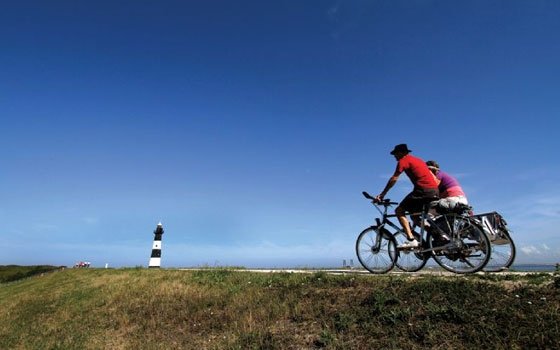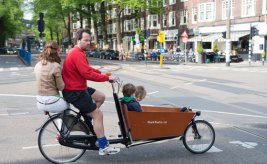
Bicycling in Holland is the best way to see the countryside and get some exercise, too — but without hills to climb. Photo from Netherlands Board of Tourism.
Is there a better place in the world for baby boomers to take to bicycles than The Netherlands?
The country is mostly flat. It’s also incredibly scenic. Distances are short. There are bike paths everywhere. And just about everyone else is on a bike, too.
Here are some amazing stats:
* Holland has 18 million bicycles — 1.5 million more than inhabitants. And 84 percent of the Dutch population owns at least one bike.
*Holland has some 18,000 miles (29,000 kilometers) of cycling paths and nearly 3,000 miles (4,700 kilometers) of roads have special lanes for cyclists.
* There are at least a dozen different types of bicycles in Holland, according to the Netherlands Board of Tourism. You’ve heard of mountain bikes, racing bikes, and tandems (bicycles built for two); you may have seen recumbent bikes and folding bikes; but have you heard of granny bikes (also called Omafiets), cargo bikes (or Bakfiets) or bar bikes?
* The city of Amsterdam alone has about 880,000 bikes, and has room for 10,000 bicycles to park around the central railway station. Nearly six out of ten Amsterdammers cycle daily, and collectively cycle more than a million miles per day.
* The longest bicycle bridge in the world, more than 2,500 feet long, spans the Amsterdam-Rhine canal. The city also has other bike-only bridges among its more than 300 miles of dedicated bike-only paths.
For visitors to the Netherlands, the government has laid out special tourist routes to follow; you can also sign up for guided bike tours throughout the country. Bike rentals are readily available.
For instance, you could take a half-day bike tour from Amsterdam along the River Amstel, which starts in the city center and leads into the countryside, where you’ll encounter historic villages and impressive country houses once owned by rich merchants.
Other Dutch cities, such as The Hague, which has more than 150 cycling paths, are also easily toured by bike. Or you could follow special routes past tulip fields during their flowering periods. In all, some 100 scenic routes have been mapped across the country.
Or you could go all out and follow the complete “Tour of the Netherlands,” which covers some 800 miles around the country and will earn you a certificate if you finish it.

One of many unusual types of bicycles in Holland. Photo from Netherlands Board of Tourism
Local tourist offices can provide maps with cycling routes. You can also ask about special accommodations for cyclists, ranging from campgrounds to private residences.
Because there are so many cyclists on the roads, cyclists have certain rights of way that you won’t find in other countries, though they still must obey all the rules of the road. Because of various protections put in place by Dutch law, Holland’s roads are now among the safest in the world for cyclists, and most ride without helmets.
All this is especially timely since Dutch tourism plans to highlight Holland as Europe’s cycling capital during 2014. It’s a great marketing strategy to lure baby boomers, who still love to ride bikes but aren’t necessarily keen to have to climb lots of hills.
In low-lying, flat, scenic Holland, all you have to do is decide what kind of bike you want, hop on and take off, for as far as you want. And you’ll be seeing the country just like the locals do.
You can find out more at the Dutch tourism website.
What do you think, readers? Is there a better country to bike in than The Netherlands?
Be sure to download my free report, “How to Ride the Coming Wave of Boomers,” available here. It’s all about the best ways to market travel to baby boomers — the biggest-spending group of travelers the world has ever seen. It’s also the easiest way to subscribe to my blog, so you won’t miss a posting. Thanks!












Leave a Reply